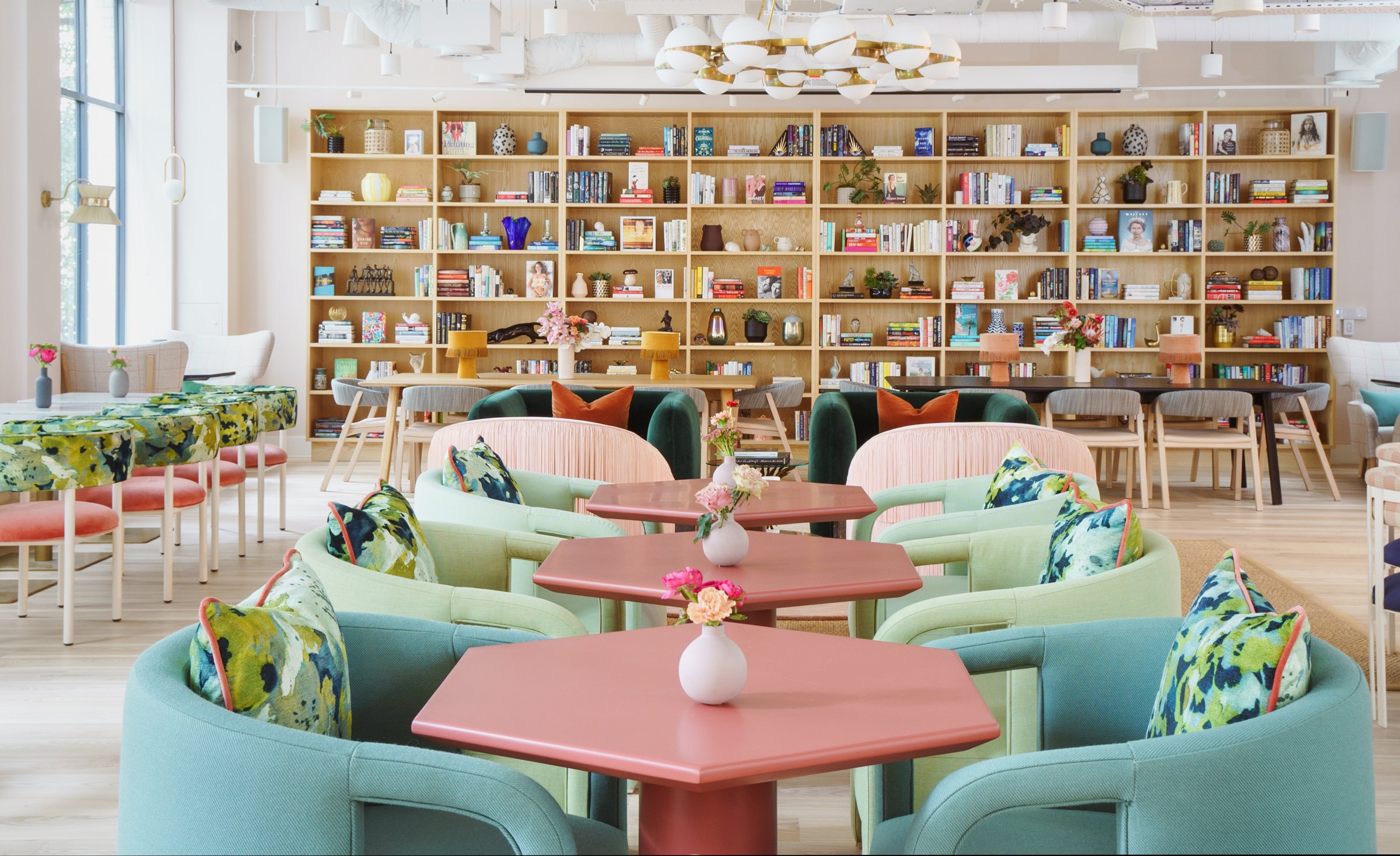
It’s the week before The Wing opens its first international location, and the final touches are being made to its five-story townhouse in London’s Fitzrovia. The space is the latest in The Wing’s roster of all-women members’ clubs and workspaces—there are eight others, in New York, L.A. and Chicago—which are dedicated to “the professional, civic, social and economic advancement of women through community.” In London, the style will be familiar to anyone who has seen The Wing’s clubs on Instagram: plush lounge chairs in jewel and pastel shades; custom wallpaper and furniture designed by female entrepreneurs; marble workstations with noise-cancelling headphones; Scandinavian-style wooden tables. Conference rooms are named after inspirational women—in London, they include journalist Christiane Amanpour and architect Zaha Hadid—and soft lamps emblazoned with ubiquitous “W” logos hang from the ceiling in The Wing’s bar and restaurant.
The Wing’s glossy aesthetic is a new addition to a recent crop of clubs springing up in London, reinventing the concept of the traditional gentlemen’s club. Historically, clubs in the capital largely catered towards upper-class and elite men. “Clubland used to be a space. It was marked on the map. Everyone knew when you walked down those streets in St James and Pall Mall [neighborhoods], that was Clubland” says Amy Milne-Smith, associate professor in history at Wilfrid Laurier University and author of London Clubland: A Cultural History of Gender and Class in Late Victorian Britain. And while women’s clubs have already existed for decades, the newer generation of clubs is drawing on that history to inform their mission in the present. “So much public good and general welfare was born out of women’s desire to see their societies be better, and so we’re just modernizing that concept,” says Zara Rahim, The Wing’s senior director of strategic communications.
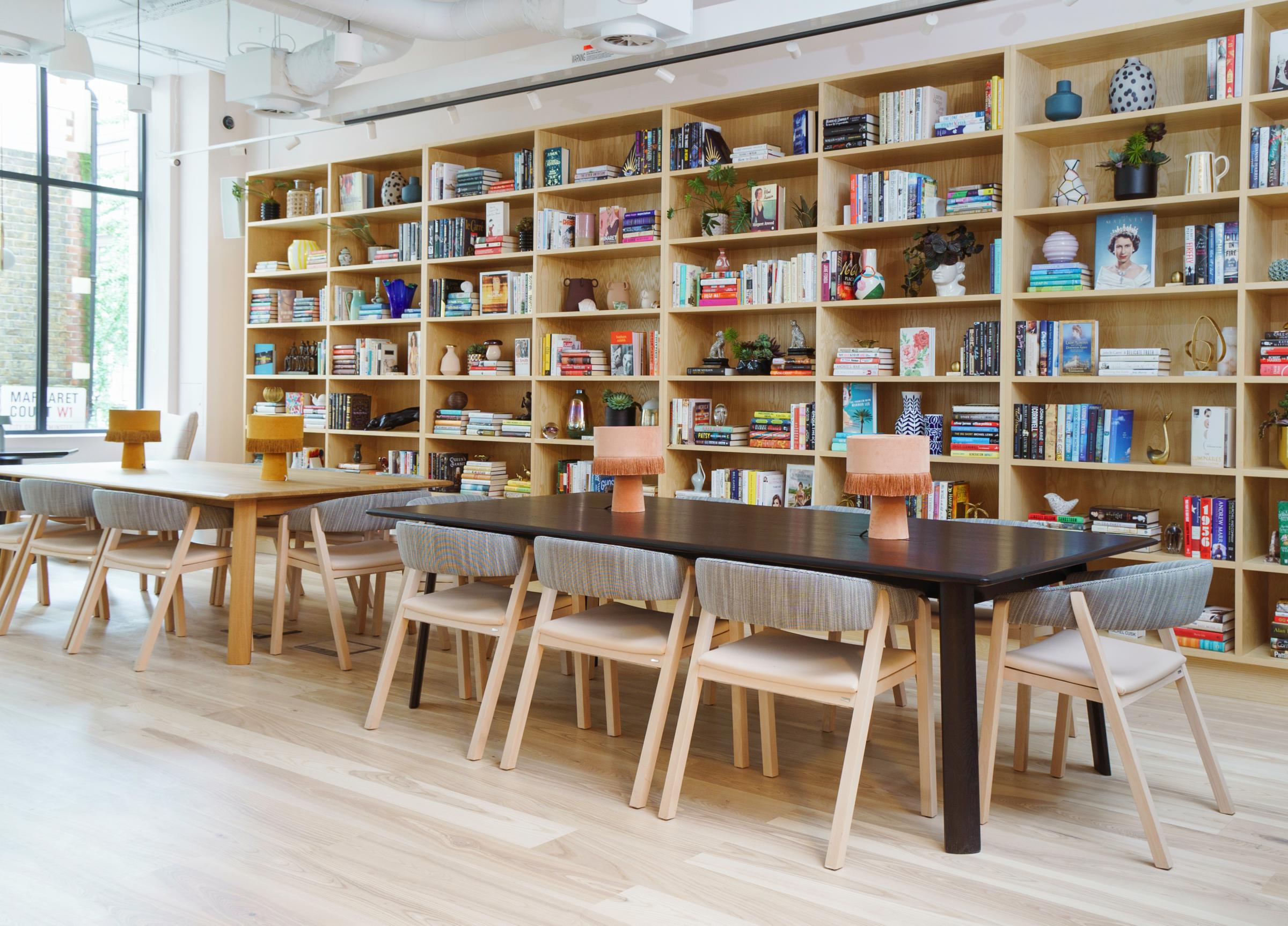
The History of Gentlemen’s Clubs in London
Gentlemen’s clubs in London date back to the 17th century, including the famously exclusive White’s Club, founded in 1693 and still in use today. And while London was not the only location for such clubs, its position at the heart of a growing British Empire in the late 19th century made it a hotspot for men’s only establishments. “Other cities had their own social institutions, but London is the heart of the type of club we are talking about, of the gentlemens’ club,” says Milne-Smith. “A lot of it has to do with the structures of London itself: The fact that it is both the political capital, and the financial capital, and the men in power who founded these clubs were always drawn to London.”
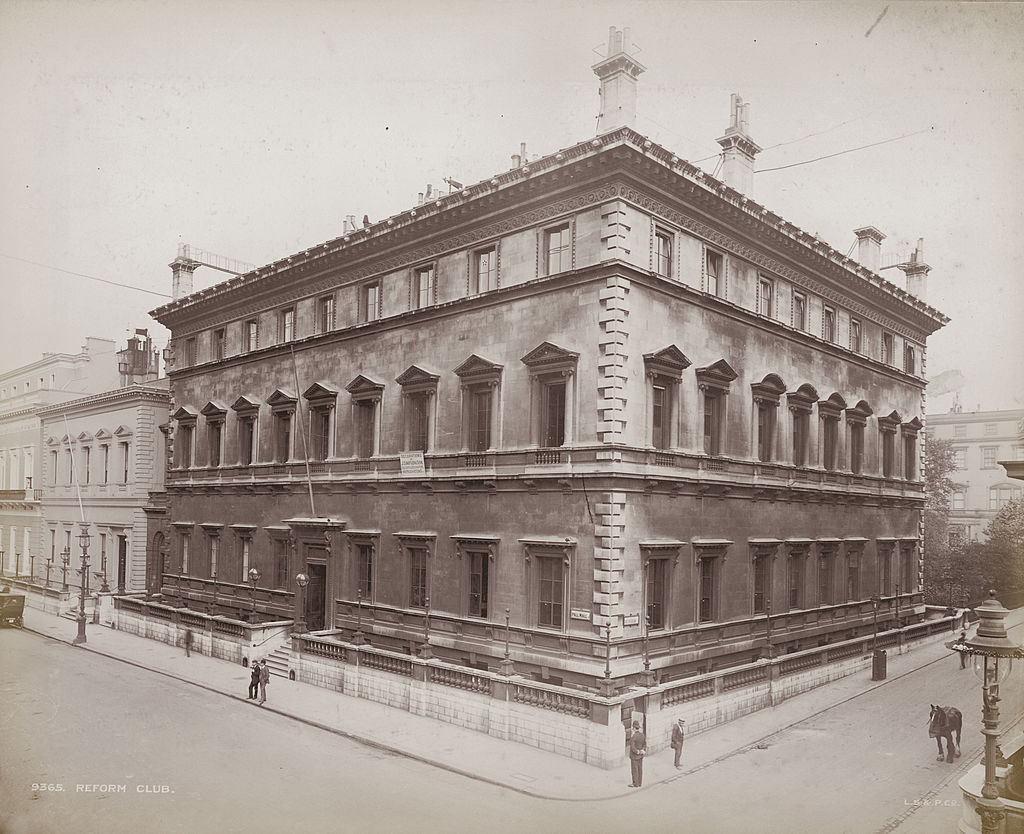
Male members of these clubs included respected writers such as Charles Dickens, and influential politicians like British Prime Minister William Gladstone. Different clubs specialized in different clientele: The diplomats would mingle at the St James Club, artists and impresarios could be found hobnobbing at the Garrick and politicians would network at the Carlton or the Reform Club. “These were the urban sites of socialization for these men,” says Milne-Smith. These men would often have a larger country house to entertain their guests, and in the days before restaurant and nightclub culture exploded in London in the 20th century, the club was the place to host people, to eat, drink and entertain in the city. Clubs were seen as a home away from home, and a place where speaking about professional business was often not permitted under stringent club rules.
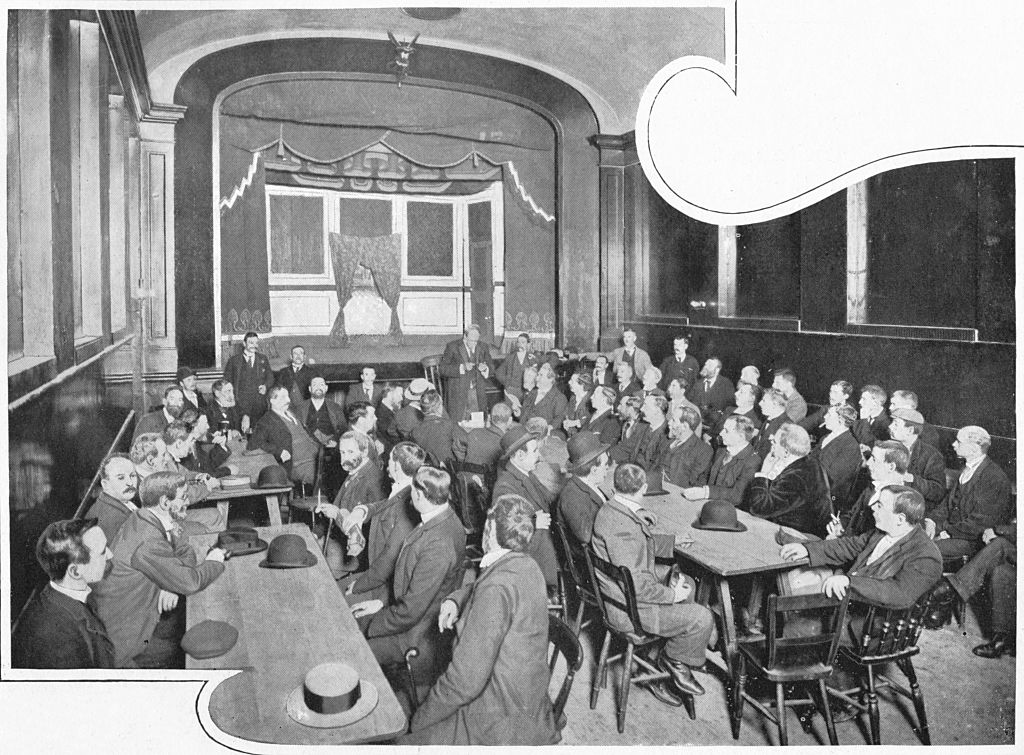
The History of Women’s Clubs in London
Traditional gender roles in Victorian Britain meant that women would largely entertain at home. “In this era, women are queens of the domestic space,” says Milne-Smith. “Elite women absolutely had exclusive sites of socializing.” That’s not to say that women’s clubs didn’t exist at the time, although there wasn’t a large movement pushing for them. Some women’s clubs established in the late 19th century mimicked the men’s club model, such as the Alexandra and Victoria Clubs, which were “for ladies of position only.” The University Women’s Club was established in 1883, and originally required women to have a university degree. It had similar aims to the gentlemen’s clubs of the era, although it put control into the hands of its female members, who are still responsible for ownership and management of the club. “It’s run by and is for women, and it does feel like a safe and relaxing space,” says Ruth Allington, chairman of the University Women’s Club. “It’s just a home from home.”
Other establishments, like the Women Journalists’ Club or the Pioneer Club, had a slightly more professional focus. “They tended to be professional networking sites, and sites for women with careers who needed a place to work in London, and to connect,” says Milne-Smith. But the lack of women working outside the home at the time meant Victorian women’s clubs had limited popularity.

The Rise of Women’s Clubs
The launch of newer clubs in London like Allbright, which opened in 2018, mark a shift in demand for women’s-only spaces. Named after Madeleine Albright, the club is billed as a networking community for businesswomen and has two locations in London, one in West Hollywood and two further planned for New York and Washington D.C.
The trend in members’ clubs becoming more women-oriented comes against the backdrop of changing ways of working in the U.K.; a report earlier this year noted that the number of women turning to self-employment has risen by 57% since 2008. Designed with spaces ideal for co-working, many freelancers are drawn to clubs like Allbright and The Wing. Meanwhile, programming networking events for members to make business connections are part of the package at The Wing, which has its own social media app specifically for members. It’s an ethos at other London clubs such as Marguerite, an all-women’s club designed for women working in the creative industries and visual arts. “The art world is so heavily based on genuine relationships and trust,” says Joanna Payne, founder and director of Marguerite, which started in her living room in 2015 and has since grown to 300 members. Although the club doesn’t have a physical location, Payne wanted to create a way for like-minded women to network and build confidence, as well as hosting high-profile female speakers and programming events. “Yes, we want to make friends, but we also want to advance our careers whilst doing so.”
How Inclusive Can an Exclusive Members’ Club Be?
For the Victorian clubs, getting in was often the trickiest part. At most clubs, any applicant required a proposer and a seconder, who both needed to be existing members. In some cases, even well-known members of elite society could be blacklisted. “It was a marker of belonging, it was perhaps the hardest marker of belonging to get because it was so difficult and temperamental and in some ways there was no logic to it,” says Milne-Smith. “There were stories of fathers putting their sons on waiting lists the moment they were born for clubs that were in demand.”
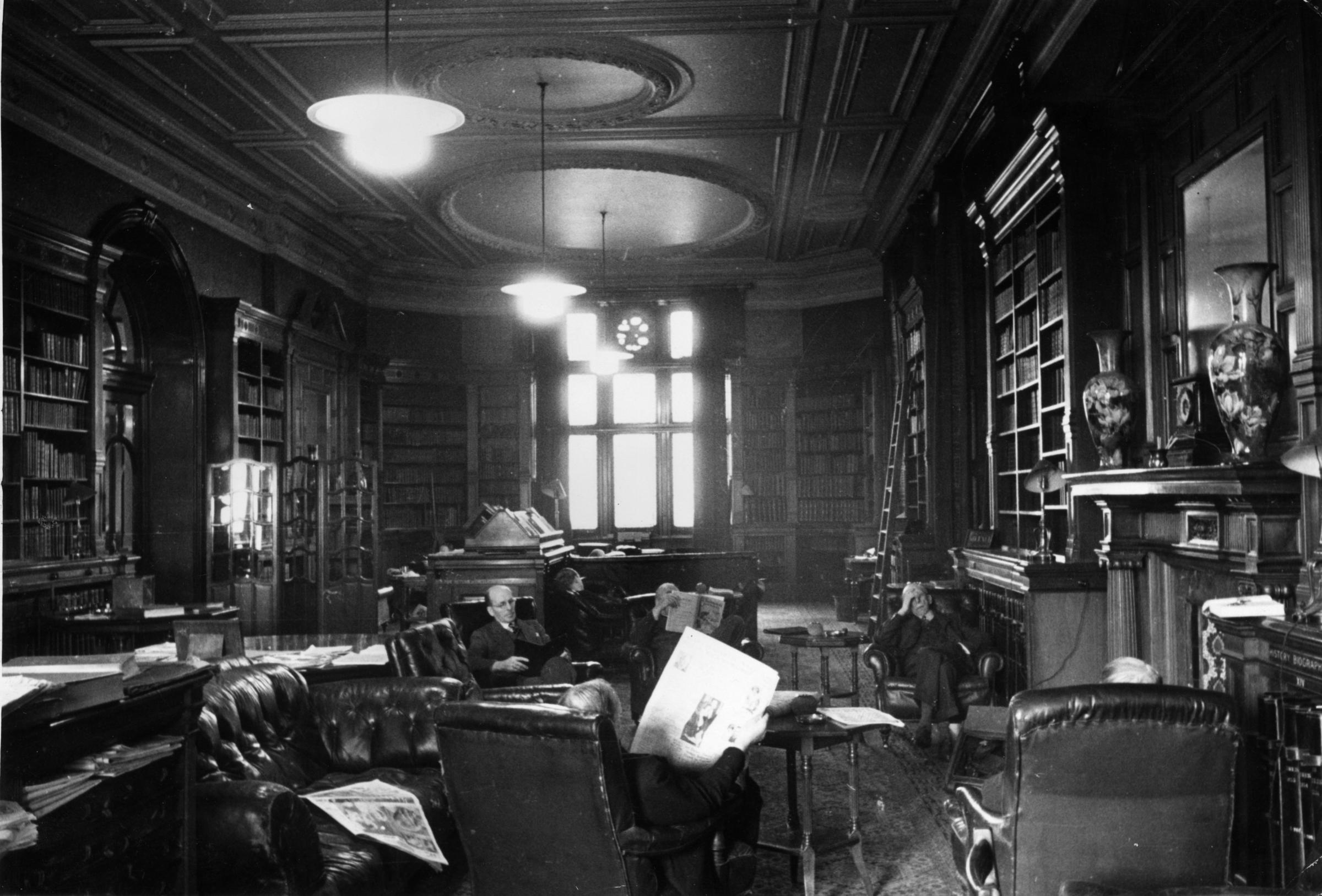
Newer clubs are trying to tackle the concept of having to know someone to become part of the club, with varying degrees of success. Marguerite, for example, offers five different membership types which start at £5 ($6.50) per month for access to the members’ section of the website and discounts on the club’s events, and requires applicants to fill out an online form answering a few simple questions. In terms of inclusivity, The Wing prefers to speak about “who we are for, versus who we are not for,” according to Zara Rahim, the company’s Senior Communications Director. “We are for progressive women, we are for folks who have suffered at the expense of the patriarchy, which includes non-binary, trans and gender non-conforming folks, and we are for black and brown women who were historically left out of the women’s club movement and were left to organize on their own.”
Yet admission still comes at a price, starting from £1836 ($2385) a year at The Wing’s London location; for comparison, other modern members’ clubs in London start from £1480 ($1914) per year at Soho House and £2650 ($3427) at The Conduit Club. The Wing also offers a scholarship program, where selected individuals working for local organizations promoting marginalized women and girls will receive free memberships to the club. “We feel very strongly that the cost of the Wing membership is reflective of an extremely rich experience, which is the ability to co-work, to build meaningful community and to participate in programming that will actually enrich the interest and goals you have,” says Rahim.

Gaining access to a club almost inherently requires some form of privilege — financial or otherwise — often antithetical to the concepts of inclusivity and diversity that several newer clubs have touted. To reach outside their membership base, clubs like the Wing have used social media, and accompanying products like magazines, merchandise and podcasts to foster a broader kind of community. It’s a move away from the more under-the-radar nature of the historic clubs, particularly the classic gentleman’s club which prided itself on its exclusivity. “Certainly now with the newer breed of clubs coming along, which are a lot more marketing and social-savvy, we deliberately try not to be that,” says Alex Maitland, General Manager at the historic University Women’s Club, which no longer requires members to have a university degree, but does require a proposer and a seconder for new members. “We do like to be discreet and reserved rather than upfront, and we always want to be very honest about what we are.”
The presence of the newer clubs is also far removed from the Victorian gentlemen’s clubs, sometimes so secretive that their name would not be displayed on the buildings; a person simply had to know where the club was in order to find it. And while clubs like The Wing are expanding what it means to be an all-women’s space, whether that’s branching into an online community or creating a network through an events program, the basic demand for such spaces in the city hasn’t changed too much. For historian Milne-Smith, there are parallels between then and now. “I can see why the women’s clubs in the 19th century and today are still trying to fill that gap of what a female networking culture looks like. Is it just mirroring the men and adding a slight twist, or is it trying to think through and create a different kind of space?”
More Must-Reads from TIME
- Cybersecurity Experts Are Sounding the Alarm on DOGE
- Meet the 2025 Women of the Year
- The Harsh Truth About Disability Inclusion
- Why Do More Young Adults Have Cancer?
- Colman Domingo Leads With Radical Love
- How to Get Better at Doing Things Alone
- Michelle Zauner Stares Down the Darkness
Contact us at letters@time.com